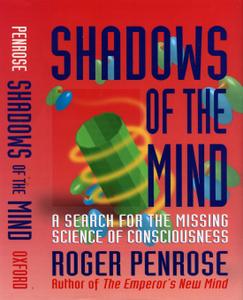Shadows of the mindA search for the missing science of conciousness
|

|
 Diese Seite wurde seit 2 Jahren inhaltlich nicht mehr aktualisiert.
Unter Umständen ist sie nicht mehr aktuell.
Diese Seite wurde seit 2 Jahren inhaltlich nicht mehr aktualisiert.
Unter Umständen ist sie nicht mehr aktuell.
 Zusammenfassungen
Zusammenfassungen
 In this book, I shall attempt to address the question of consciousness fron a scientific standpoint. But I shall strongly contend - by use of scientific argument - that an essential ingredient is missing from our present-day scientific picture.
In this book, I shall attempt to address the question of consciousness fron a scientific standpoint. But I shall strongly contend - by use of scientific argument - that an essential ingredient is missing from our present-day scientific picture. A New York Times bestseller when it appeared in 1989, Roger Penrose's The Emperor's New Mind was universally hailed as a marvelous survey of modern physics as well as a brilliant reflection on the human mind, offering a new perspective on the scientific landscape and a visionary glimpse of the possible future of science. Now, in Shadows of the Mind, Penrose offers another exhilarating look at modern science as he mounts an even more powerful attack on artificial intelligence. But perhaps more important, in this volume he points the way to a new science, one that may eventually explain the physical basis of the human mind.
A New York Times bestseller when it appeared in 1989, Roger Penrose's The Emperor's New Mind was universally hailed as a marvelous survey of modern physics as well as a brilliant reflection on the human mind, offering a new perspective on the scientific landscape and a visionary glimpse of the possible future of science. Now, in Shadows of the Mind, Penrose offers another exhilarating look at modern science as he mounts an even more powerful attack on artificial intelligence. But perhaps more important, in this volume he points the way to a new science, one that may eventually explain the physical basis of the human mind.Penrose contends that some aspects of the human mind lie beyond computation. This is not a religious argument (that the mind is something other than physical) nor is it based on the brain's vast complexity (the weather is immensely complex, says Penrose, but it is still a computable thing, at least in theory). Instead, he provides powerful arguments to support his conclusion that there is something in the conscious activity of the brain that transcends computation–and will find no explanation in terms of present-day science. To illuminate what he believes this "something" might be, and to suggest where a new physics must proceed so that we may understand it, Penrose cuts a wide swathe through modern science, providing penetrating looks at everything from Turing computability and Godel's incompleteness, via Schrodinger's Cat and the Elitzur-Vaidman bomb-testing problem, to detailed microbiology. Of particular interest is Penrose's extensive examination of quantum mechanics, which introduces some new ideas that differ markedly from those advanced in The Emperor's New Mind, especially concerning the mysterious interface where classical and quantum physics meet. But perhaps the most interesting wrinkle in Shadows of the Mind is Penrose's excursion into microbiology, where he examines cytoskeletons and microtubules, minute substructures lying deep within the brain's neurons. (He argues that microtubules–not neurons–may indeed be the basic units of the brain, which, if nothing else, would dramatically increase the brain's computational power.) Furthermore, he contends that in consciousness some kind of global quantum state must take place across large areas of the brain, and that it within microtubules that these collective quantum effects are most likely to reside.
For physics to accommodate something that is as foreign to our current physical picture as is the phenomenon of consciousness, we must expect a profound change–one that alters the very underpinnings of our philosophical viewpoint as to the nature of reality. Shadows of the Mind provides an illuminating look at where these profound changes may take place and what our future understanding of the world may be.
 Bemerkungen zu diesem Buch
Bemerkungen zu diesem Buch
 Es gibt keinerlei Hinweise darauf, dass es im Gehirn bei kognitiven oder verhaltenssteuernden Geschehnissen quantenphysisch zugeht, wie etwa der Mathematiker Roger Penrose meint. Die kleinsten Prozesse, die im Gehirn von Tieren und Menschen überhaupt irgendetwas bewirken können, z. B. das Öffnen und Schliessen eines einzigen Ionenkanals oder die Entleerung eines transmittergefüllten Vesikels an der präsynaptischen Membran, mögen in ihrem Auftreten als Einzelereignisse eventuell ein partiell indeterminiertes Verhalten zeigen (was umstritten ist), in Kombination mit Milliarden derselben Vorgänge muss sich dies völlig ausmitteln.
Es gibt keinerlei Hinweise darauf, dass es im Gehirn bei kognitiven oder verhaltenssteuernden Geschehnissen quantenphysisch zugeht, wie etwa der Mathematiker Roger Penrose meint. Die kleinsten Prozesse, die im Gehirn von Tieren und Menschen überhaupt irgendetwas bewirken können, z. B. das Öffnen und Schliessen eines einzigen Ionenkanals oder die Entleerung eines transmittergefüllten Vesikels an der präsynaptischen Membran, mögen in ihrem Auftreten als Einzelereignisse eventuell ein partiell indeterminiertes Verhalten zeigen (was umstritten ist), in Kombination mit Milliarden derselben Vorgänge muss sich dies völlig ausmitteln. Kapitel
Kapitel 
- 1. Consciousness and computation (Seite 7 - 63)

 Dieses Buch erwähnt ...
Dieses Buch erwähnt ...
 Dieses Buch erwähnt vermutlich nicht ...
Dieses Buch erwähnt vermutlich nicht ... 
 Nicht erwähnte Begriffe | Church-Turing-These |
 Tagcloud
Tagcloud
 Zitate im Buch
Zitate im Buch
 Most of the material of our bodies and brains, after all, is being continuously replaced, and it is just its pattern that persists.
Most of the material of our bodies and brains, after all, is being continuously replaced, and it is just its pattern that persists. My own position is that questions of mind, though they lie very uncomnfortably with present-day scientific understanding, should not be regarded as being forever outside the realms of science.
My own position is that questions of mind, though they lie very uncomnfortably with present-day scientific understanding, should not be regarded as being forever outside the realms of science. A scientific world-view which does not profoundly come to terms with the problem of conscious minds can have no serious pretensions of completeness. Consciousness is part of our universe, so any physical theory which makes no proper place for it falls fundamentally short of providing a genuine description of the world.
A scientific world-view which does not profoundly come to terms with the problem of conscious minds can have no serious pretensions of completeness. Consciousness is part of our universe, so any physical theory which makes no proper place for it falls fundamentally short of providing a genuine description of the world. Zitationsgraph
Zitationsgraph
 Zitationsgraph (Beta-Test mit vis.js)
Zitationsgraph (Beta-Test mit vis.js)
 Zeitleiste
Zeitleiste
 13 Erwähnungen
13 Erwähnungen 
- Das Gehirn und seine Wirklichkeit - Kognitive Neurobiologie und ihre philosophischen Konsequenzen (Gerhard Roth) (1994)


- Spiral Dynamics - mastering values, leadership, and change (Don Eward Beck, Christophe C. Cowan) (1996)


- Der Computer als didaktisches Medium - Über die Mythen des Mediums und das Lernen von Subjekten (Rupert Röder) (1998)


- Philosophy and Computing - An Introduction (Luciano Floridi) (1999)

- The Religion of Technology - The Divinity of Man and the Spirit of Invention (David F. Noble) (1999)

- Ich fühle, also bin ich - Die Entschlüsselung des Bewusstseins (Antonio R. Damasio) (2000)


- 1. Ins Licht treten
- Fühlen - Denken - Handeln - Die neurobiologischen Grundlagen des menschlichen Verhaltens (Gerhard Roth) (2001)


- Radical Evolution - The Promise and Peril of Enhancing Our Minds, Our Bodies - and What It Means to Be Human (Joel Garreau) (2006)

- How Mathematicians Think - Using Ambiguity, Contradiction, and Paradox to Create Mathematics (William Byers) (2007)

- The Philosophy of Information (Luciano Floridi) (2011)

- Beyond Zero and One (Andrew Smart) (2015)

- The Feeling of Life Itself - Why Consciousness Is Widespread but Can’t Be Computed (Christof Koch) (2020)


- Bildung und Digitalität - Analysen – Diskurse – Perspektiven (Sandra Aßmann, Norbert Ricken) (2023)


- Klassisch - Modern - Digital? - Eine kleine Geschichte und Systematik des Wissensbegriffs, mit einer Note zur digitalen Bildung (Helmut Pulte)


- Klassisch - Modern - Digital? - Eine kleine Geschichte und Systematik des Wissensbegriffs, mit einer Note zur digitalen Bildung (Helmut Pulte)
 Co-zitierte Bücher
Co-zitierte Bücher

Die Debatte um künstliche Intelligenz, Bewusstsein und die Gesetze der Physik
The Emperor’s New Mind
(Roger Penrose) (1989)


Der Mann, der seine Frau mit einem Hut verwechselte
The man who mistook his wife for a hat
(Oliver Sacks) (1985)




Der mittlere Weg der Erkenntnis
Der Brückenschlag zwischen wissenschaftlicher Theorie und menschlicher Erfahrung
The Embodied Mind
(Francisco J. Varela, Evan Thompson, Eleanor Rosch) (1991)


Understanding Computers and Cognition
A New Foundation for Design
(Terry Winograd, Fernando Flores) (1987)


The Power of Human Intuition and Expertise in the Era of the Computer
(Hubert L. Dreyfus, S. Dreyfus) (1986)

Logik der Forschung
(Karl R. Popper) (1973)Objektive Erkenntnis
(Karl R. Popper) (1973)Syntactic Structures
(Noam Chomsky) (1957)The Organization of Behavior
(Donald Hebb) (1949)Mind Children
(Hans Moravec)Conjectures and Refutations
(Karl R. Popper) (1963)
Unified Theories of Cognition
(Alan Newell) (1990)
 Volltext dieses Dokuments
Volltext dieses Dokuments
 | Consciousness and computation: Artikel als Volltext ( : :  , 1434 kByte) , 1434 kByte) |
 | Shadows of the mind: Gesamtes Buch als Volltext ( : :  , 5472 kByte) , 5472 kByte) |
 Externe Links
Externe Links
 Penrose: Science and Mind: Unter "Media" gibt es einen Audio-Download von Roger Penrose zum Thema ( Penrose: Science and Mind: Unter "Media" gibt es einen Audio-Download von Roger Penrose zum Thema (  : :  2021-03-21) 2021-03-21) | |
 Beyond the Doubting of a Shadow: A Reply to Commentaries on Shadows of the Mind by Roger Penrose ( Beyond the Doubting of a Shadow: A Reply to Commentaries on Shadows of the Mind by Roger Penrose (  : :  Link unterbrochen? Letzte Überprüfung: 2021-03-21 Letzte erfolgreiche Überprüfung: 2009-09-13) Link unterbrochen? Letzte Überprüfung: 2021-03-21 Letzte erfolgreiche Überprüfung: 2009-09-13) |
 Standorte
Standorte 
 Bibliographisches
Bibliographisches 
 Beat und dieses Buch
Beat und dieses Buch
 Beat hat dieses Buch vor seiner Dissertation ins Biblionetz aufgenommen. Die bisher letzte Bearbeitung erfolgte während seiner Zeit am Institut für Medien und Schule. Beat besitzt ein physisches und ein digitales Exemplar. (das er aber aus Urheberrechtsgründen nicht einfach weitergeben darf). Beat selbst sagt, er habe dieses Dokument gelesen.
Beat hat dieses Buch vor seiner Dissertation ins Biblionetz aufgenommen. Die bisher letzte Bearbeitung erfolgte während seiner Zeit am Institut für Medien und Schule. Beat besitzt ein physisches und ein digitales Exemplar. (das er aber aus Urheberrechtsgründen nicht einfach weitergeben darf). Beat selbst sagt, er habe dieses Dokument gelesen.








 Algorithmus
Algorithmus Computer
Computer Gehirn
Gehirn Intelligenz
Intelligenz Künstliche Intelligenz (KI / AI)
Künstliche Intelligenz (KI / AI) Neuron
Neuron Neuronales Netz
Neuronales Netz Physik
Physik Wissenschaft
Wissenschaft Zufall
Zufall (
(

























 Biblionetz-History
Biblionetz-History